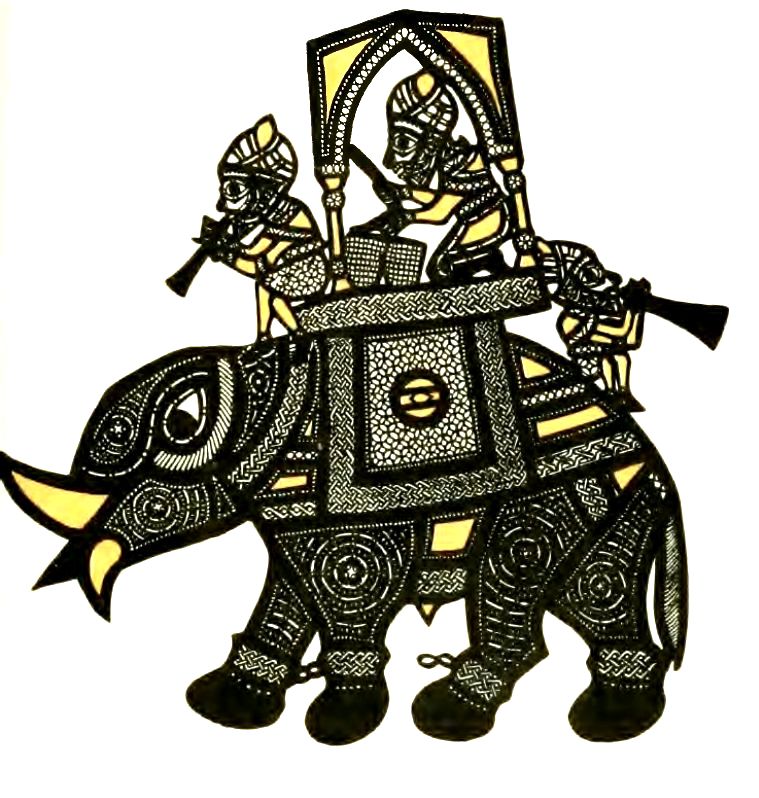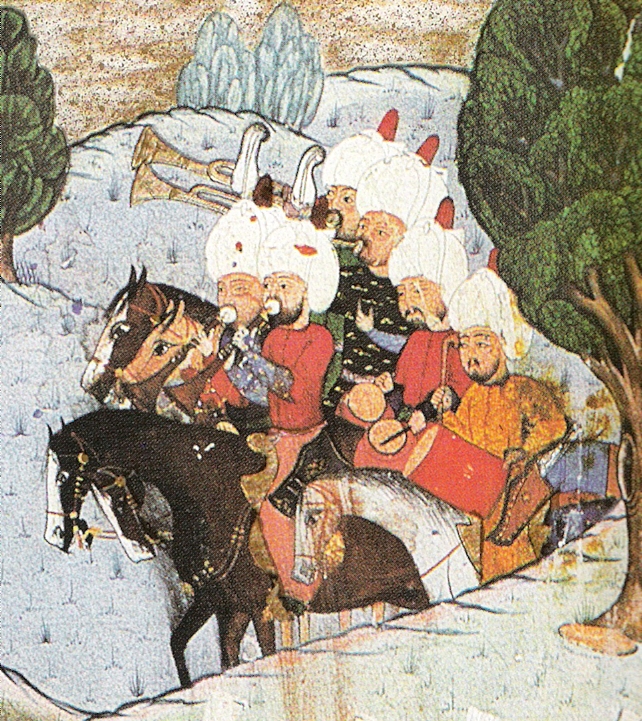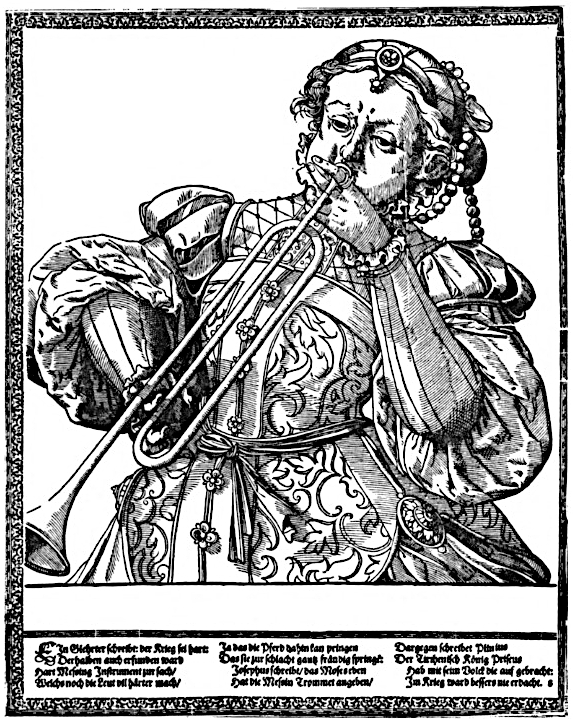|
Buisine
The ''buisine'' and the ''añafil'' were variations of a type of straight medieval trumpet usually made of metal, also called a herald's trumpet. While arguably the same instrument, the two names represent two separate traditions, in which a Persian-Arabic-Turkic instrument called the ''Nafir'' entered European culture in different places and times. The term ''buisine'' (Old French; also, ''busine'', ''buysine'', ''buzine'') descends from ''Buccina'', a Roman military horn. The horn was mainly used for military and ceremonial purposes. When Europeans went to the crusades, the instrument was seen as a proper military target (in the same way a flag or pendant was), something to capture and bring home. The term ''añafil'' descends from ''al-Nafir'', the Persian-Arab Islamic trumpet which was used by Moorish armies in Spain, before the Crusades. By the Reconquista (722–1492) when residents of the future Spain retook the Iberian Peninsula, ''añafil'' was part of the nation's lan ... [...More Info...] [...Related Items...] OR: [Wikipedia] [Google] [Baidu] |
Añafil
The ''buisine'' and the ''añafil'' were variations of a type of straight medieval trumpet usually made of metal, also called a herald's trumpet. While arguably the same instrument, the two names represent two separate traditions, in which a Persian-Arabic-Turkic instrument called the ''Nafir'' entered European culture in different places and times. The term ''buisine'' (Old French; also, ''busine'', ''buysine'', ''buzine'') descends from ''Buccina'', a Roman military horn. The horn was mainly used for military and ceremonial purposes. When Europeans went to the crusades, the instrument was seen as a proper military target (in the same way a flag or pendant was), something to capture and bring home. The term ''añafil'' descends from ''al-Nafir'', the Persian-Arab Islamic trumpet which was used by Moorish armies in Spain, before the Crusades. By the Reconquista (722–1492) when residents of the future Spain retook the Iberian Peninsula, ''añafil'' was part of the nation's lan ... [...More Info...] [...Related Items...] OR: [Wikipedia] [Google] [Baidu] |
Nafir
''Nafir'' (Arabic نَفير, DMG ''an-nafīr''), also ''nfīr'', plural ''anfār'', Turkish ''nefir'', is a slender shrill-sounding straight natural trumpet with a cylindrical tube and a conical metal bell, producing one or two notes. It was used as a military signaling instrument and as a ceremonial instrument in countries shaped by Islamic culture in North Africa, the Middle East and South Asia. In Ottoman, Persian and Mugulin miniatures, the ''nafīr'' is depicted in battle scenes. Similar straight signal trumpets have been known since ancient Egyptian times and among the Assyrians and Etruscans. After the fall of the Roman Empire, the straight-tubed Roman tuba, continued to flourish in the Middle East among the Sassanids and their Arabic successors. The Saracens, whose long metal trumpets greatly impressed the Christian armies at the time of the Crusades, were ultimately responsible for reintroducing the instrument to Europe after a lapse of six hundred years. The straight ... [...More Info...] [...Related Items...] OR: [Wikipedia] [Google] [Baidu] |
Nafir
''Nafir'' (Arabic نَفير, DMG ''an-nafīr''), also ''nfīr'', plural ''anfār'', Turkish ''nefir'', is a slender shrill-sounding straight natural trumpet with a cylindrical tube and a conical metal bell, producing one or two notes. It was used as a military signaling instrument and as a ceremonial instrument in countries shaped by Islamic culture in North Africa, the Middle East and South Asia. In Ottoman, Persian and Mugulin miniatures, the ''nafīr'' is depicted in battle scenes. Similar straight signal trumpets have been known since ancient Egyptian times and among the Assyrians and Etruscans. After the fall of the Roman Empire, the straight-tubed Roman tuba, continued to flourish in the Middle East among the Sassanids and their Arabic successors. The Saracens, whose long metal trumpets greatly impressed the Christian armies at the time of the Crusades, were ultimately responsible for reintroducing the instrument to Europe after a lapse of six hundred years. The straight ... [...More Info...] [...Related Items...] OR: [Wikipedia] [Google] [Baidu] |
Nafir (trumpet)
''Nafir'' (Arabic نَفير, DMG ''an-nafīr''), also ''nfīr'', plural ''anfār'', Turkish ''nefir'', is a slender shrill-sounding straight natural trumpet with a cylindrical tube and a conical metal bell, producing one or two notes. It was used as a military signaling instrument and as a ceremonial instrument in countries shaped by Islamic culture in North Africa, the Middle East and South Asia. In Ottoman, Persian and Mugulin miniatures, the ''nafīr'' is depicted in battle scenes. Similar straight signal trumpets have been known since ancient Egyptian times and among the Assyrians and Etruscans. After the fall of the Roman Empire, the straight-tubed Roman tuba, continued to flourish in the Middle East among the Sassanids and their Arabic successors. The Saracens, whose long metal trumpets greatly impressed the Christian armies at the time of the Crusades, were ultimately responsible for reintroducing the instrument to Europe after a lapse of six hundred years. The straight ... [...More Info...] [...Related Items...] OR: [Wikipedia] [Google] [Baidu] |
Al-Nafir
''Nafir'' (Arabic نَفير, DIN 31635, DMG ''an-nafīr''), also ''nfīr'', plural ''anfār'', Turkish ''nefir'', is a slender shrill-sounding straight natural trumpet with a cylindrical tube and a conical metal bell, producing one or two notes. It was used as a military signaling instrument and as a ceremonial instrument in countries shaped by Islamic culture in North Africa, the Middle East and South Asia. In Ottoman, Persian and Mugulin miniatures, the ''nafīr'' is depicted in battle scenes. Similar straight signal trumpets have been known since ancient Egyptian times and among the Assyrians and Etruscans. After the fall of the Roman Empire, the straight-tubed Roman tuba, continued to flourish in the Middle East among the Sassanids and their Arabic successors. The Saracens, whose long metal trumpets greatly impressed the Christian armies at the time of the Crusades, were ultimately responsible for reintroducing the instrument to Europe after a lapse of six hundred years. The ... [...More Info...] [...Related Items...] OR: [Wikipedia] [Google] [Baidu] |
Fanfare Trumpet
A fanfare trumpet, also called a herald trumpet, is a brass instrument similar to but longer than a trumpet, capable of playing specially composed fanfares. Its extra length can also accommodate a small ceremonial banner that can be mounted on it. It differs from its precursor, the Medieval buisine, by being coiled rather than straight, and from the clarion trumpet and natural trumpet by possibly having valves. Historical background ''See: Nafir'', Clarion Fanfare trumpet-like instruments existed in ancient Rome (like the Roman tuba), while Iran, Korea and China sport similar traditional instruments (''karnay'', ''nafir'', ''nabal'' and ''laba'' in the latter three). Beginning in the late Middle Ages, straight herald trumpets (known as the buisine) and later coiled valve-less natural trumpets and drums (usually snares and tenors) would sound fanfares to mark important holidays or ceremonial events. These instruments would also serve as timekeepers in various towns and anno ... [...More Info...] [...Related Items...] OR: [Wikipedia] [Google] [Baidu] |
Fanfare Trumpet
A fanfare trumpet, also called a herald trumpet, is a brass instrument similar to but longer than a trumpet, capable of playing specially composed fanfares. Its extra length can also accommodate a small ceremonial banner that can be mounted on it. It differs from its precursor, the Medieval buisine, by being coiled rather than straight, and from the clarion trumpet and natural trumpet by possibly having valves. Historical background ''See: Nafir'', Clarion Fanfare trumpet-like instruments existed in ancient Rome (like the Roman tuba), while Iran, Korea and China sport similar traditional instruments (''karnay'', ''nafir'', ''nabal'' and ''laba'' in the latter three). Beginning in the late Middle Ages, straight herald trumpets (known as the buisine) and later coiled valve-less natural trumpets and drums (usually snares and tenors) would sound fanfares to mark important holidays or ceremonial events. These instruments would also serve as timekeepers in various towns and anno ... [...More Info...] [...Related Items...] OR: [Wikipedia] [Google] [Baidu] |
Clarion (instrument)
Clarion is a common name for a trumpet in the Middle Ages and the Renaissance. It also is used as a name for a 4' organ reed stop. There is wide confusion over whether clarion invariably refers to a type of trumpet or simply the upper register of the standard trumpet. Etymology "Clarion" derives from three Latin words: the noun ''clario'' (trumpet), the adjective ''clarus'' (bright or clear), and the verb ''claro'' (to make clear). Throughout Europe, an eclectic set of variations on clarion came into use. The meaning of these variations was not standard. It is not clear whether they are meant to refer to an actual instrument or simply the high register of the trumpet. In France, the usage evolved into words like "clairin", "clarin", "clerain", "clerin", "clairon", "claroncel", and "claronchiel". Clairon become the most commonly used version. English variants were "claro", "clario", "clarone", "clarasius", "clarioune", "claryon" and "clarion". In Spain, the terminology became "cla ... [...More Info...] [...Related Items...] OR: [Wikipedia] [Google] [Baidu] |
Brass Instrument
A brass instrument is a musical instrument that produces sound by sympathetic vibration of air in a tubular resonator in sympathy with the vibration of the player's lips. Brass instruments are also called labrosones or labrophones, from Latin and Greek elements meaning 'lip' and 'sound'. There are several factors involved in producing different pitches on a brass instrument. Slides, valves, crooks (though they are rarely used today), or keys are used to change vibratory length of tubing, thus changing the available harmonic series, while the player's embouchure, lip tension and air flow serve to select the specific harmonic produced from the available series. The view of most scholars (see organology) is that the term "brass instrument" should be defined by the way the sound is made, as above, and not by whether the instrument is actually made of brass. Thus one finds brass instruments made of wood, like the alphorn, the cornett, the serpent and the didgeridoo, while some ... [...More Info...] [...Related Items...] OR: [Wikipedia] [Google] [Baidu] |
Al-Andalus
Al-Andalus DIN 31635, translit. ; an, al-Andalus; ast, al-Ándalus; eu, al-Andalus; ber, ⴰⵏⴷⴰⵍⵓⵙ, label=Berber languages, Berber, translit=Andalus; ca, al-Àndalus; gl, al-Andalus; oc, Al Andalús; pt, al-Ândalus; es, al-Ándalus () was the Muslim-ruled area of the Iberian Peninsula. The term is used by modern historians for the former Islamic states in modern Spain and Portugal. At its greatest geographical extent, it occupied most of the peninsula and a part of present-day southern France, Septimania (8th century). For nearly a hundred years, from the 9th century to the 10th, al-Andalus extended its presence from Fraxinetum into the Alps with a series of organized raids and chronic banditry. The name describes the different Arab and Muslim states that controlled these territories at various times between 711 and 1492. These boundaries changed constantly as the Christian Reconquista progressed,"Para los autores árabes medievales, el término Al-And ... [...More Info...] [...Related Items...] OR: [Wikipedia] [Google] [Baidu] |
Middle Ages
In the history of Europe, the Middle Ages or medieval period lasted approximately from the late 5th to the late 15th centuries, similar to the post-classical period of global history. It began with the fall of the Western Roman Empire and transitioned into the Renaissance and the Age of Discovery. The Middle Ages is the middle period of the three traditional divisions of Western history: classical antiquity, the medieval period, and the modern period. The medieval period is itself subdivided into the Early, High, and Late Middle Ages. Population decline, counterurbanisation, the collapse of centralized authority, invasions, and mass migrations of tribes, which had begun in late antiquity, continued into the Early Middle Ages. The large-scale movements of the Migration Period, including various Germanic peoples, formed new kingdoms in what remained of the Western Roman Empire. In the 7th century, North Africa and the Middle East—most recently part of the Eastern Ro ... [...More Info...] [...Related Items...] OR: [Wikipedia] [Google] [Baidu] |
Umayyad Conquest Of Hispania
The Umayyad conquest of Hispania, also known as the Umayyad conquest of the Visigothic Kingdom, was the initial expansion of the Umayyad Caliphate over Hispania (in the Iberian Peninsula) from 711 to 718. The conquest resulted in the decline of the Visigothic Kingdom and the establishment of the Umayyad Wilayah of Al-Andalus. During the caliphate of the sixth Umayyad caliph al-Walid I (), forces led by Tariq ibn Ziyad disembarked in early 711 in Gibraltar at the head of an army consisting of Berbers from north Africa. After defeating the Visigothic king Roderic at the decisive Battle of Guadalete, Tariq was reinforced by an Arab force led by his superior ''wali'' Musa ibn Nusayr and continued northward. By 717, the combined Arab-Berber force had crossed the Pyrenees into Septimania. They occupied further territory in Gaul until 759. Background The historian al-Tabari transmits a tradition attributed to the Caliph Uthman who stated that the road to Constantinople was throug ... [...More Info...] [...Related Items...] OR: [Wikipedia] [Google] [Baidu] |








